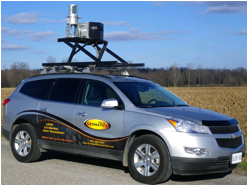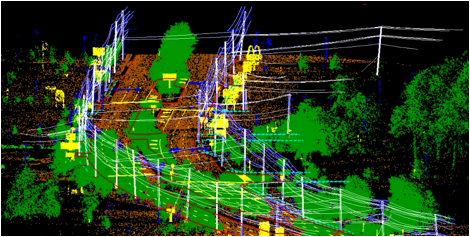- Homepage
- >
- Electric Grid Hardening old
- >
- 3-D Imaging for Modernization
3-D Imaging for Modernization
The U.S. power grid is the largest interconnected machine on earth, with over 9,000 electric generating units connected to over 300,000 miles of transmission lines. Eversource operates over 4,200 miles of this transmission system and over 72,000 pole miles of distribution lines across Connecticut, Massachusetts and New Hampshire.
With air-and ground-level laser technology, Eversource and UConn are capturing hundreds of thousands to millions of data points in a pilot study in Greenwich, Connecticut. The result will be a three-dimensional picture of the overhead electric delivery infrastructure and surrounding trees. This study area is a pilot for combining 3-D information with UConn’s software to create a detailed picture of the grid’s health pole-by-pole.
Identification of infrastructure integrity and upgrades will be a primary benefit for the town, ensuring reliable power and will serve as an example for additional towns in the future. This leading-edge data will add to Eversource’s Roadside Tree and Forest Management work where vegetation growth rates are dynamic, to the Outage Prediction Modeling focused on avoiding and shortening outages, and will complement ongoing research on Integrating Renewable Generation.

|
Goals & Project Updates
Project Updates
Pilot studies were recently flown in March 2016 using one airborne and one ground-based laser scanning system.
The goals for this project are to:
- Demonstrate the capabilities and evaluate the costs of 3-D image acquisition for two pilot studies utilizing air- and ground-based laser scanner systems.
- Perform cost-benefit analyses of laser scanner systems using scientific and professional literature, as well as consultation with vendors and utility companies.
- Use 3-D imagery to analyze changes in vegetation between 2012 and 2016, and estimate the optimal time interval at which data need to be reacquired to remain effective.
- Develop software to map utility poles and lines from 3-D imagery.
- Explore the use of 3-D imaging in remotely assessing the structural integrity of utility poles.
The purpose of this research is to:
- Help utilities understand the capabilities of laser scanning technology.
- Determine if this technology can improve the efficiency with which utilities manage their infrastructure.
- Provide important insights for the Mapping Tree Risk and Outage Prediction projects.
Print / Media
Related Links
Team Members
|
Emmanouil Anagnostou, Professor of Civil and Environmental Engineering, University of Connecticut. |
|
Dave Wanik, Assistant Research Professor, Department of Civil and Environmental Engineering, University of Connecticut. |
|
Tom Meyer, Associate Professor, Department of Natural Resources and the Environment, University of Connecticut. |
|
Wei Zhang, Assistant Professor, Department of Civil and Environmental Engineering, University of Connecticut. |
| Chandi Witharana, Research Assistant Professor, Natural Resources and the Environment, University of Connecticut. |
Contact Information
|
For more information, please contact Chandi Witharana (chandi.witharana@uconn.edu) or Dave Wanik (dave.wanik@uconn.edu) Members of the media, please contact Center Manager Malaquias Pena (mpena@uconn.edu) directly. |
Eversource Energy Center | Innovation Partnership Building: 159 Discovery Drive, Unit 5276, Storrs, CT 06269-5276 | E-Mail: eversourceenergycenter@uconn.edu



